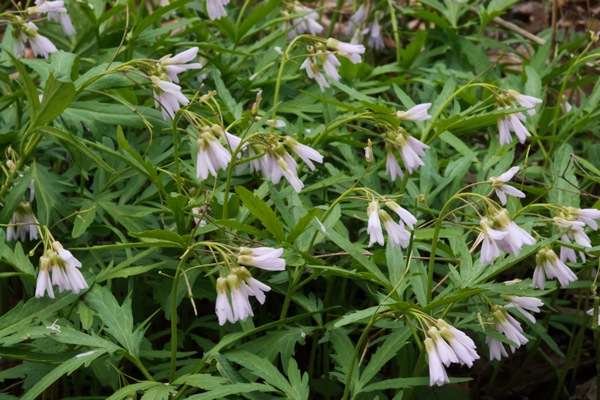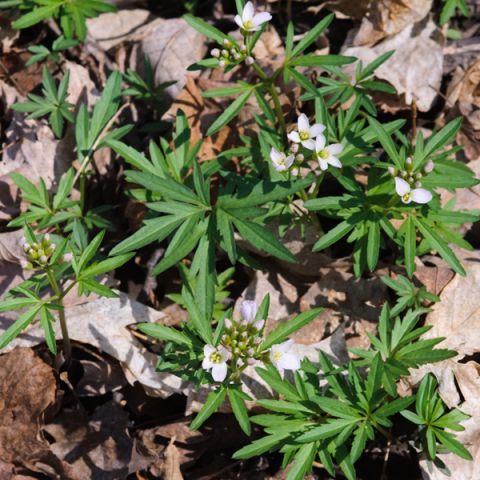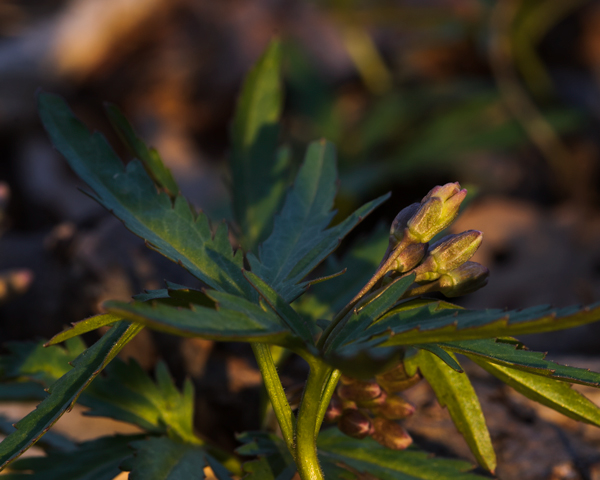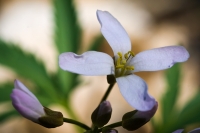You can find it in Riverside Park, where it lights up the forest floor with clusters of white, four- petalled flowers. It’s a native perennial of eastern North America, growing from Quebec in the north to Florida in the south, and west to Texas and North Dakota.
The word "ephemeral" comes from a Greek word meaning "lasting for a day," and the wildflowers we call ephemerals seem barely to last even that long – you have to get out there and see them while you can!
But ephemerals like cutleaf toothwort don’t just last for a day. They live dormant in the soil for most of the year, sprouting from the same rootstock when they can. Just because we say plants "die down" after seeding doesn’t mean they actually die. They take advantage of the sunlight that the bare trees of early spring let through, sending up leaves and putting out flowers to attract pollinators while they can. They reproduce, make seeds, then live underground until next spring.
Thankfully for us, botanical reproduction means beautiful flowers, and the cutleaf toothwort is a very beautiful flower indeed.

Taken by the author in Riverside Park, Milwaukee, WI.
Cutleaf toothwort grows in the rich mesic forests that used to characterize much of Wisconsin’s landscape. Mesic means "middle." Mesic forests are the Goldilocks forests, between hydric (or wet) forests and xeric (or dry) forests. Not too wet, not too dry.
It blooms in the early spring, from mid-April to early-May in our area. After skunk cabbage – the undisputed champion of early blooming in Wisconsin – cutleaf toothwort is one of the earliest flowers you’ll find.
So how do you identify cutleaf toothwort?
The most distinctive feature is the leaves. Each leaf has five thin, serrated sections. It’s what botanists would call deeply dissected. Imagine a maple leaf. Now imagine cutting away (or dissecting) most of the leaf tissue between the primary veins. That’s pretty much what the leaf of a cutleaf toothwort looks like, and is where the cutleaf part of its name comes from.
You might also remember it by one of its other common names: crow’s toes. Once you learn what to look for, you’ll be picking out toothwort easily.

Taken by the author in McGilvra Woods State Natural Area near Baraboo, WI.
Cutleaf toothwort grows in colonies, because it grows by rhizomes. Rhizomes are underground stems, different from roots. Cutleaf toothwort mostly spreads by sending out its tuberous rhizomes, then sending up stems for leaves and flowers. The toothwort does also propagate by seeds, but when you find a patch of toothwort, notice how it grows in a clump. That’s a result of its rhizomatic growth.
There are little growths on the rhizomes that look something like teeth, which are actually scars from previous years’ stems. They are the probable origin of the common name toothwort. Another origin might be from its traditional use as a remedy for toothache. That remedy, however, might have come about because of the tooth-like shapes on the rhizomes, so it could be a bit of a circle.
The rhizomes are edible. They apparently taste something like radishes, which leads to another of its common names: pepper root. That they’re edible is not surprising to learn when you know what family of plants the cutleaf toothwort belongs to.
Cutleaf toothwort is one of the over 600 species of plants in the family Brassicaceae found in the US.
Brassicaceae, commonly known as the mustard or cabbage family, contains numerous well-known plants, including broccoli, radish, horseradish, turnip, canola, and many others. The highly invasive garlic mustard and dame’s rocket that Urban Ecology Center land stewards try so hard to control are also species in Brassicaceae.
One of the shared features of all the species in Brassicaceae is a four-petaled flower in the shape of a cross. Cutleaf toothwort is an excellent example.

Taken by the author in Riverside Park, Milwaukee, WI.
The flowers are about ½” to 1” wide. They are generally white, but often have a lovely pinkish hue, particularly when they’re young. They have four petals, four sepals and six stamens. They grow in clusters (or racemes) of a variable number of flowers on thin stems. The clusters tend to droop, so you have to get down on your knees to really see the flowers.
They attract bees, butterflies and flies, providing an early source of nourishment to insects. After pollination, the leaves wither, the plant often falls over, and the flowers turn into thin pods (or siliques) that ripen from green to brown over the course of spring. They then twist and split open, dropping the seeds to hopefully start a new patch of toothwort.
If you’re visiting Riverside Park, try to find a patch of cutleaf toothwort! It’s one of the under-appreciated natural jewels of Milwaukee.
Do you have any comments, corrections or suggestions? Please get in touch with me at This email address is being protected from spambots. You need JavaScript enabled to view it.. I will be writing a series of blogs on native Wisconsin wildflowers for the Urban Ecology Center over the course of the coming months.
This article was written by Jonathan Abresch. Jonathan is an American-Canadian writer and photographer who loves learning about and being in nature.





